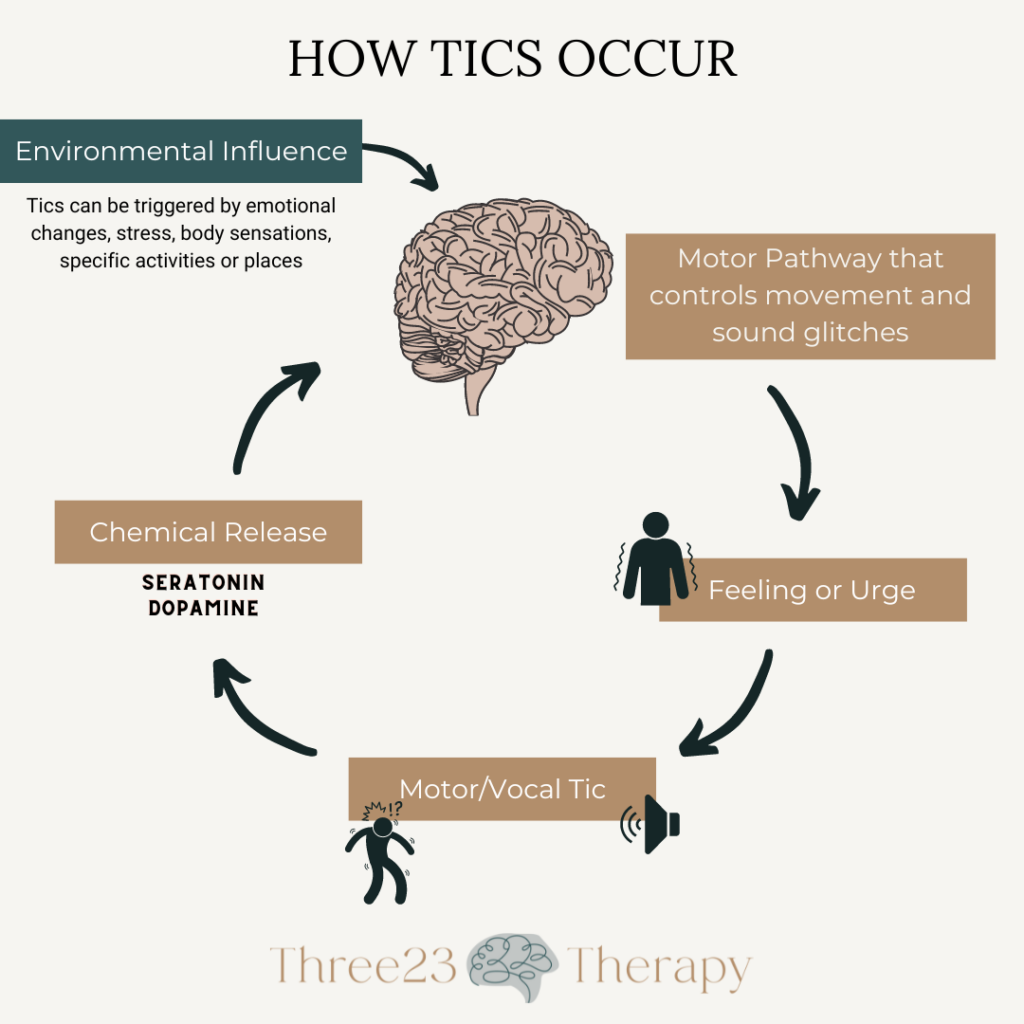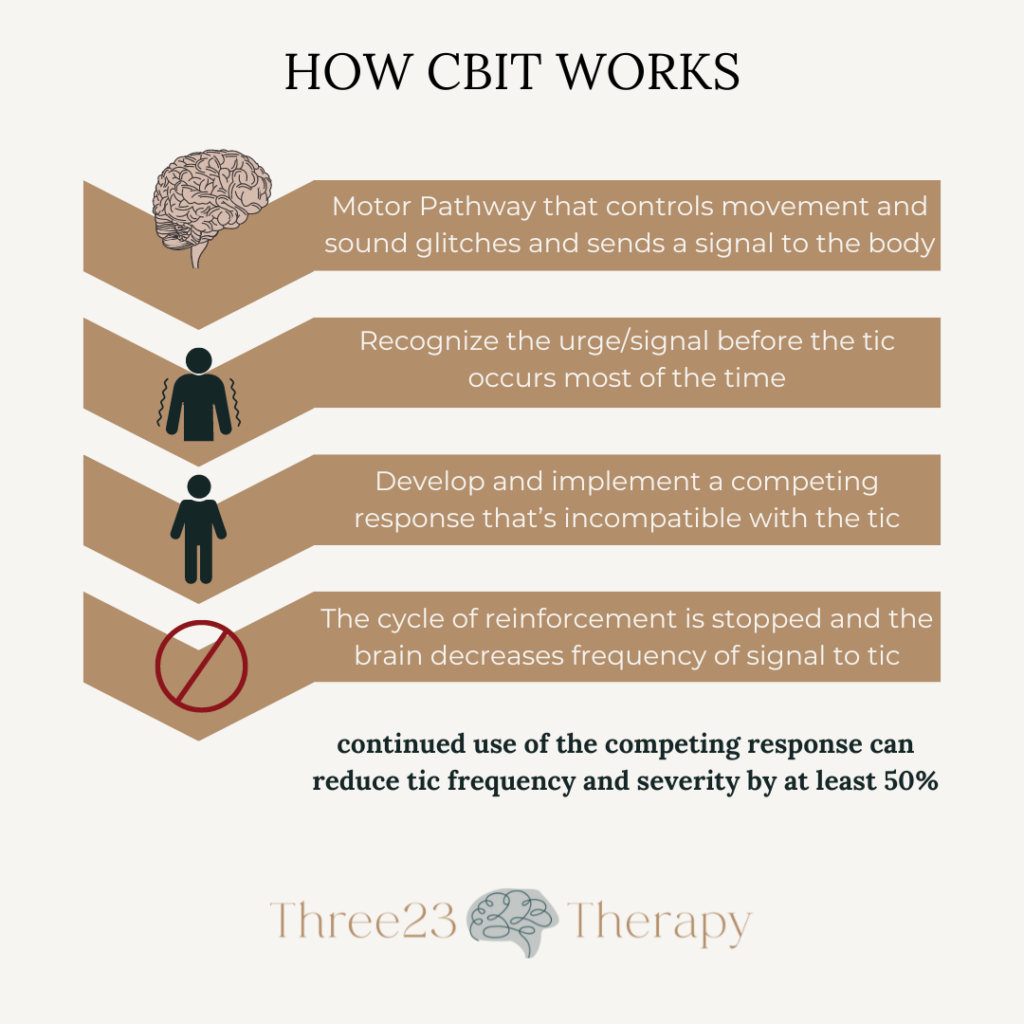Emily Reid
I help people reduce and control their tics and take control of their anxiety.
Learn More →
TIC THERAPY
anxiety therapy
Resources
CBIT Therapy versus Suppressing Tics
September 25, 2024
Comprehensive Behavior Intervention for Tics (CBIT) therapy is a program designed to reduce the frequency and severity of tics by at least 50%. It’s highly effective, but must be implemented properly and systematically. When I talk to potential clients or people who’ve lived with tics for a long time, they often ask how CBIT therapy is different than holding tics back or redirecting tics to another part of their body. I’m hoping this will serve as an educational resource to you, and by the end of this post you’ll understand the difference between the two as well as why suppressing tics can be more harmful than helpful.
Breaking Down CBIT Therapy
CBIT therapy is essentially a two step process. First, we identify all of the different tics that are currently present and then we pick one to work on first. The reason we address one tic at a time is because each tic typically has it’s own physical/psychological urge before the tic actually manifests. Here’s a simple breakdown of how tics happen.

It all starts in the brain in the motor pathway. Basically, that motor pathway is supposed to control all voluntary movement and sound. Sometimes, that motor pathway glitches and it sends an urge or feeling to a specific part of the body. Once that urge is recognized by the body part, it wants to eliminate the unwanted or foreign sensation. This when the tic occurs. A tic makes the urge go away (even for a second) which provides some relief to the brain. This is why there’s a little chemical release back into the brain that’s basically saying “that felt good, thank you for doing that tic to make that uncomfortable urge go away.” Because the brain is so reward driven and likes those happy chemicals of dopamine and serotonin, it happens again and again. There’s also lots of environmental triggers that can make tics happen more such as change in routine, stress, lack of sleep, screen time, etc.
That’s the simple version of how tics happen. Now that you’ve got a basic understanding of how tics happen in the brain, let’s breakdown the differences between CBIT therapy and Suppression
CBIT Therapy – Comprehensive Behavior Intervention for Tics
CBIT therapy is designed specifically for treating tics. It’s effective for simple, complex, motor, and vocal tics. Because tics have their own individual urge that occurs right before the physical manifestation, one tic is addressed at a time with CBIT. A client will choose one tic to address first. Usually, the most bothersome tic is addressed first because there’s more motivation for the client to put in the effort required for success. Once the tic is determined, it’s essentially a two-step process from there.
- Awareness of the urge: The goal of step one is get a really good understanding of what the body feels right before the tic comes out. In this step, we outline all the components of the tic, define how it physically manifests, and identify any environmental triggers (excitement, car rides, boredom, crowded places, lack of sleep, caffeine, etc.). Once we identified some of these factors, the client will spend a period of time (usually a few days) practicing identifying the urge they feel before the specific tic we’re addressing. They practice awareness training everyday, throughout the day to make the brain super aware of that feeling before the tic comes. The goal of awareness training is that the client can recognize the urge before the tic physically manifests about 80% of the time.
- Competing Response: Once the client can successfully feel the urge before the tic manifests, we develop an alternative positive, movement, and/or breathing pattern that has to follow a specific set of rules. The competing response should be less noticeable than the tic and as physically incompatible as possible. We develop the competing response based on where the urge is felt and how the tic physically manifests. It can be different for each person and each tic. Once a competing response is developed, the client must implement the competing response when they feel the urge and maintain the competing response until the urge completely goes away on its own. That’s one of the most important steps. By doing this, we stop the reinforcement and happy chemical release in the brain and it will then learn to reduce the frequency of which it sends the signal to tic. Here’s a visual below.

The implementation of CBIT is very important. It is systematic and implemented in a specific order. If you don’t follow the “rules” or use the strategies consistently, you won’t see the results you want. However, if you implement it as it’s designed, then you’ll notice a big reduction in the frequency and severity of the tics.
Suppressing Tics
Suppression or holding back the tics is an informal way people try to control or stop their tics. It’s completely understandable because tics can be disturbing, painful, annoying, or socially distracting. However, suppression is when a person does anything and everything to tell themselves or force themselves not to tic for a specific period of time. It’s not structured or systematic. If a child is in class and knows the expectation is to be quiet and not disruptive, they’re telling themselves throughout the entire class “don’t tic” or squeezing/tensing all of their muscles to prevent it from happening. They might even be trying to change the tic into a less noticeable version of the original tic. Teens and adults do this too, mostly in social or professional settings. It’s the only way they can temporarily prevent the tic from coming out. Sometimes it’s effective, while other times it’s not. Individuals with tics will often describe suppression as exhausting, ineffective, or very uncomfortable. Suppression is not a long term solution to controlling tics. In fact, it can potentially increase the frequency and number of tics a person has.
Consequences of Suppressing Tics
It’s not just that holding the tics back temporarily is ineffective. For some, suppressing tics can lead to more frequent and severe tics. Here’s what can happen when someone suppresses often.
- After suppressing tics, they will come out in an “explosive” fashion. For example, if someone holds in their tics during a class, meeting, or social event, they may notice a significant increase in tics when they finally let them go. I often compare this to a volcano erupting with tics. Parents observe this after school when kids come home and let their tics go. Teens and adults often experience this when they’re alone.
- Because a person is holding back the tic or potentially modifying it to be less noticeable, it can essentially create a new tic. Let’s say you have a head jerk to the side. If you modify this by rolling your neck instead of jerking your neck, you’re still giving the tic satisfaction, but in a different way. This essentially gives the body another way to tic and now you have Neck Jerk 1.0 and Neck Jerk 2.0. Most people don’t want to add more tics to their repertoire, so although it masks the noticeable version, it creates another tic all together.
- Exhaustion. People will often tell me they become so tired and fatigued from holding in their tics all day. This is both physical and emotional exhaustion. Imagine focusing so hard on not moving your body or making a sound while having to get all of your work done during the day. It takes a toll on the brain and body.
- Some people who hold their tics in for extended periods of time experience more than just an “explosion” of tics; they experience tic attacks. Tic attacks can really vary in severity but it’s usually a burst of tics for a few minutes that can be very aggressive (usually to self) and they all happen at once. There’s no controlling or stopping the tics in this moment. The most important strategy is keeping the person ticcing safe. You usually have to wait out a tic attack (a different approach is used for FND clients). When the tic attack is over, the person returns to their baseline.
Remember, suppression is doing anything and everything you can to temporarily stop the tics. There’s no structure or system in place. However, CBIT therapy is highly structured with a focus on responding to the urge to tic in the same way almost every time. This is what retrains the brain to decrease the frequency and severity. The brain learns through consistent action.
Stop Suppressing Tics
My first piece of advice for every new client is to stop holding their tics back. Just let them go. When a person let’s the tics out, the tics are less likely to be as intense and there’s less of chance of developing new versions of the same tic. If a person is suppressing tics, it’s usually a subtle sign that the tics are bothering them. When a person is bothered by their tics, that’s when intervention is recommended. If a person is trying to suppress their tics because it only bothers others but not themselves, the recommendation is still to let the tics out. However, there are some considerations here. . . If a person has a vocal tic that is highly distracting in a learning or working environment, it might be appropriate to seek intervention, even if the tic does not bother the ticcer. When the tic becomes disruptive to them or to others with the consideration made above, that’s when it’s appropriate to seek CBIT therapy. CBIT will quickly and effectively teach the ticcer the skills to recognize the urge or warning signal of their tic and respond to it differently so they have improved control and reduced frequency of their tics. And not all tics have to be addressed. If a person wants to on one out of their four tics, that’s okay! It wont make the other tics worse or impact effectiveness of the tic being addressed. Overall, my recommendation is try CBIT if the tic bothersome, or let the tic free if it’s not bothersome.
Leave a Reply Cancel reply
Tic Presentation Checklist
A practical guide to help families, educators, and providers distinguish between typical and functional tics and support informed decisions about care and treatment
Tic Symptom Checklist
A comprehensive checklist to track motor and vocal tics, related behaviors, and patterns to support monitoring and communication with healthcare providers.
Supporting Students in School
A parent-friendly guide to help teachers understand tics, respond appropriately, and implement classroom strategies that support students’ learning and well-being.